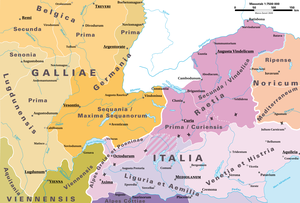Maxima Sequanorum
The Roman province of Maxima Sequanorum (also Sequania , Sequanica or Sequanicum ) was named after the Celtic tribe of the Sequaner . It emerged from the part of the province Germania superior ("Upper Germany") south of Strasbourg , when it was divided up in the course of the administrative and military reforms of the Roman emperor Diocletian (284-305) in AD 297. The existence of this province can be proven until the middle of the 5th century. The civil administration of the province was in the hands of a praeses , who had his seat in Vesontio ( Besançon ). The units of the Roman border army ( Limitanei ) stationed in the province of Maxima Sequanorum , however, were under the command of a Dux provinciae Sequanicae .
The province of Maxima Sequanorum comprised areas in what is now north-western Switzerland and in eastern France. It belonged to the prefecture of Gallia and was assigned to the Dioecesis Galliae in its division into dioceses .
There were four municipal areas within the province:
- Civitas Vesontiensium , main town Vesontio ( Besançon )
- Colonia Iulia Equestris , capital Noviodunum ( Nyon )
- Civitas Helvetiorum , main town Aventicum ( Avenches )
- Colonia Augusta Raurica , capital Augusta Raurica ( Augst / Kaiseraugst ).
